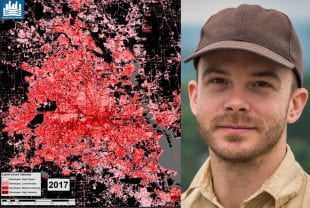As Houston grows at a pace rivaled by few American cities, how can it mitigate the impact of future floods?
Chris Hakkenberg, a scholar at Rice University’s Kinder Institute for Urban Research, has developed an innovative way to illustrate exactly how the Bayou City has changed over the past two decades. The result is a dramatic visual record of Houston’s growth in the 21st century.
Instead of the conventional practice of collecting data on housing starts and real estate parcels to track urban growth, this new research takes advantage of supercomputing, artificial intelligence and, most importantly, a constellation of satellites that have been capturing images of the Greater Houston area from 438 miles above Earth for past decades.
“Seeing these maps in motion really helps to visualize what lies behind the numbers on Houston’s dramatic population growth,” Hakkenberg said. “Looking across the space, we see whole ecosystems of highways and commercial real estate, retail and residential neighborhoods emerge upon the landscape in rapid succession.”
The technique documents changes in Houston’s land cover with a series of GIFs dating back to the late 20th century. The compelling visualization shows not just where the city is growing and when, but how fast and at what densities of urban cover. The data product is unique for its simultaneous fine resolution and vast extent in space and time. All data products are freely available on the Kinder Institute’s Urban Data Platform (UDP).
The methodology is described in an International Journal of Remote Sensing article by Hakkenberg entitled “Characterizing multi-decadal, annual land cover change dynamics in Houston, TX, based on automated classification of Landsat imagery.” He explained the development of his approach to harness artificial intelligence to interpret satellite images in a consistent and unbiased manner.
Hakkenberg was especially interested in documenting how the conversion of 800 square miles of farms, wetlands and forests to impervious surfaces in the last 21 years can exacerbate the effects of the colossal rainfall events the city has experienced in recent years. In all, 20% of these newly converted lands fell within the Federal Emergency Management Agency’s 100-year flood plain; 14% were within federally recognized wetland habitat.
“Houston’s dramatic growth is a point of pride for this diverse and dynamic city,” Hakkenberg said. “However, if the past is prologue to the future, then the city should be especially concerned that unbridled development, especially in flood plains and wetlands, could exacerbate potentially catastrophic flooding risks in an increasingly unstable climate future.”
Hakkenberg said rapid and vast urbanization coupled with more frequent and intense hurricanes could have devastating consequences, especially for the city’s most vulnerable residents.
“Planning for these contingencies will, at the regional scale, require a concerted effort to make sure that prevention and post-disaster recovery are included in future development plans,” he said.
Hakkenberg said the tool is designed so that urban planners and public policymakers can make informed choices to prepare for and recover from disasters.
“I hope these advances in remote sensing and machine learning image interpretation will provide planners and policymakers access to the state-of-the-art data and tools they’ll need to make informed and life-saving choices,” he said.
The research was funded by Houston Endowment, the Kinder Institute and the Rice Academy of Fellows. A copy of the summary paper and a technical paper are both available online, and the full GIS map time series is freely accessible on the Kinder Institute’s UDP.


